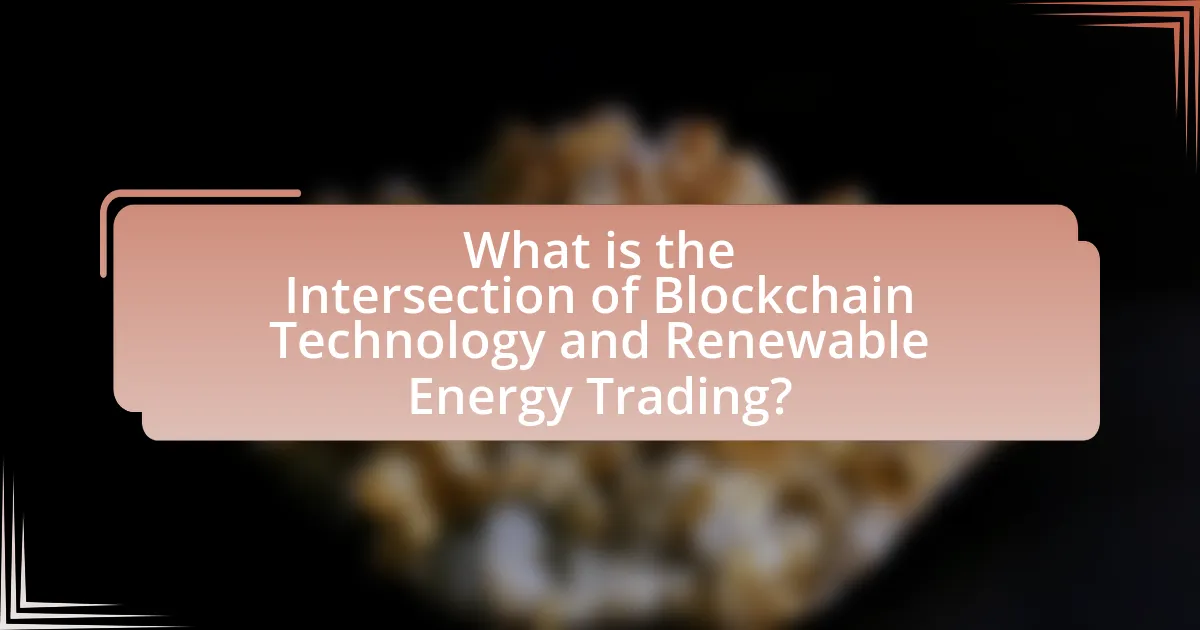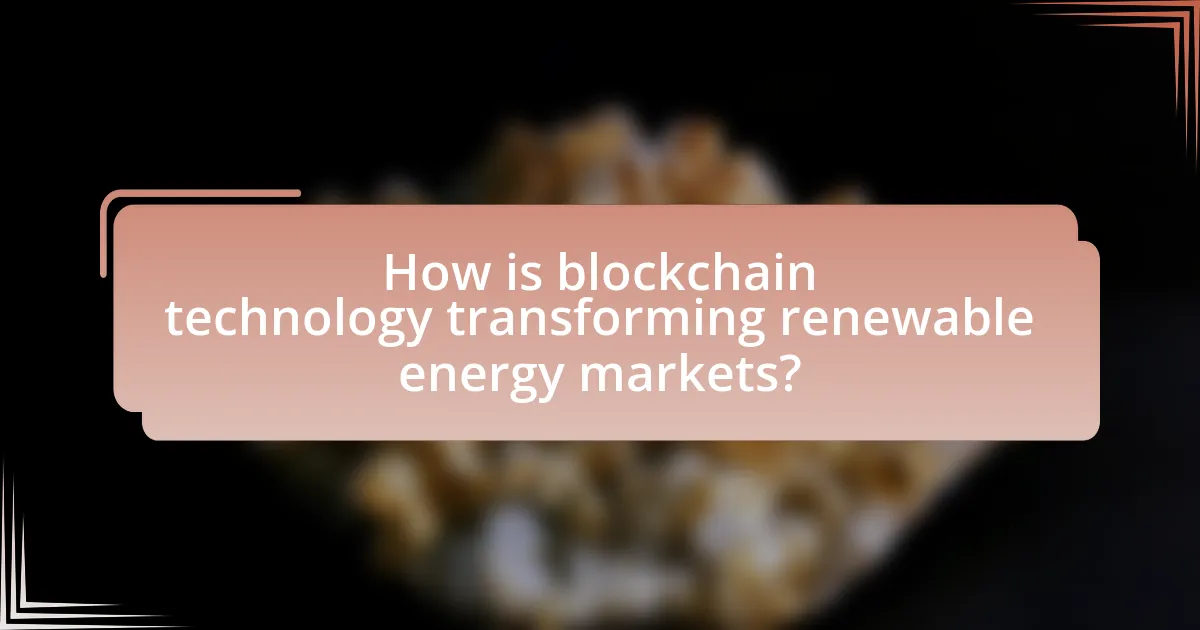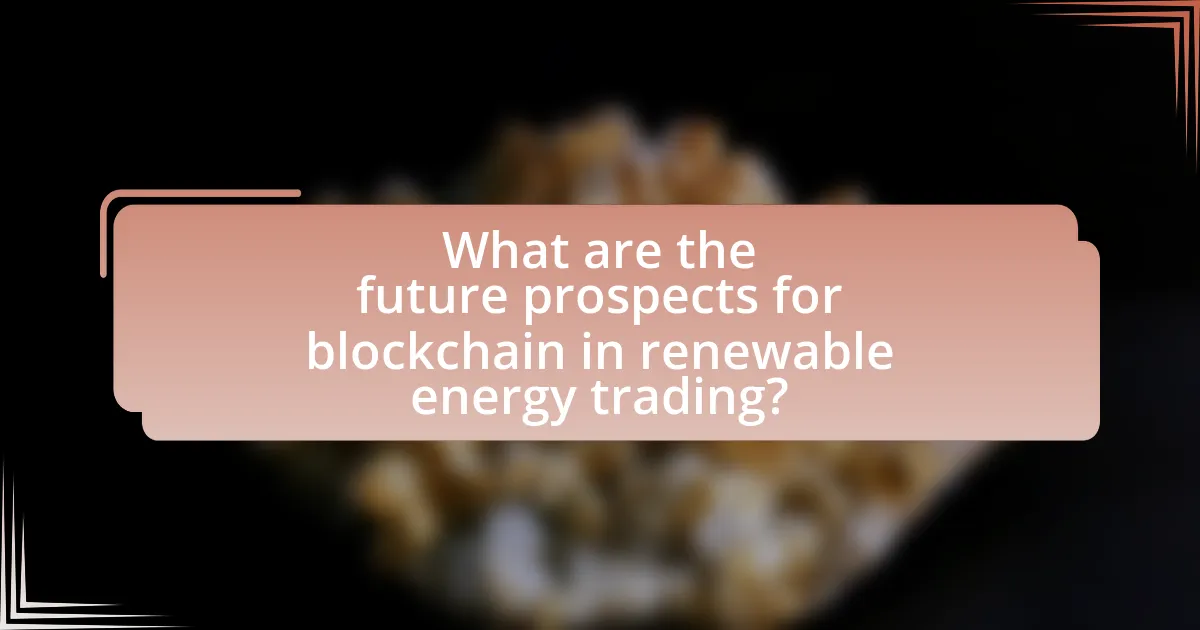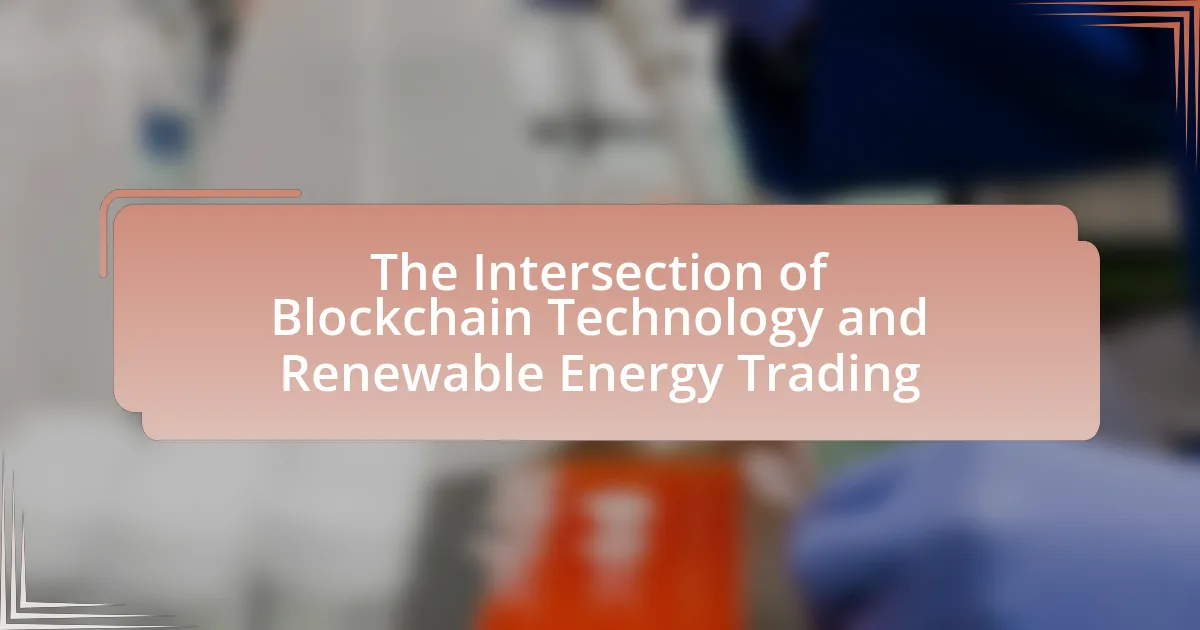The article focuses on the intersection of blockchain technology and renewable energy trading, highlighting how decentralized ledger systems facilitate transparent, efficient, and secure transactions in the energy market. It discusses the benefits of blockchain, including peer-to-peer trading, enhanced transparency, and reduced transaction costs, while also addressing challenges such as scalability, regulatory uncertainty, and integration with existing energy systems. Key features like smart contracts and decentralization are examined for their roles in improving energy trading efficiency. The article further explores future prospects, innovations, and best practices for implementing blockchain in renewable energy trading, emphasizing the importance of collaboration among stakeholders to enhance adoption in energy markets.

What is the Intersection of Blockchain Technology and Renewable Energy Trading?
The intersection of blockchain technology and renewable energy trading involves the use of decentralized ledger systems to facilitate transparent, efficient, and secure transactions of renewable energy. Blockchain enables peer-to-peer energy trading, allowing consumers to buy and sell excess energy directly without intermediaries, which can reduce costs and increase market participation. For instance, projects like Power Ledger and LO3 Energy have demonstrated successful implementations of blockchain in local energy markets, showcasing how blockchain can enhance trust and traceability in energy transactions.
How does blockchain technology facilitate renewable energy trading?
Blockchain technology facilitates renewable energy trading by enabling decentralized and transparent transactions between energy producers and consumers. This technology allows for peer-to-peer energy trading, where individuals can buy and sell excess energy directly without intermediaries, thus reducing costs and increasing efficiency. Smart contracts, which are self-executing contracts with the terms of the agreement directly written into code, automate the trading process, ensuring that transactions are executed securely and transparently. For instance, a study by the International Renewable Energy Agency (IRENA) highlights that blockchain can enhance the efficiency of energy markets by providing real-time data on energy production and consumption, thereby facilitating quicker and more reliable trading decisions.
What are the key features of blockchain that enhance energy trading?
The key features of blockchain that enhance energy trading include decentralization, transparency, and smart contracts. Decentralization allows for peer-to-peer transactions without intermediaries, reducing costs and increasing efficiency. Transparency ensures that all participants have access to the same information, which builds trust and reduces disputes. Smart contracts automate the execution of agreements based on predefined conditions, streamlining processes and minimizing the need for manual intervention. These features collectively improve the efficiency, reliability, and security of energy trading systems.
How does decentralization impact renewable energy transactions?
Decentralization significantly enhances renewable energy transactions by enabling peer-to-peer trading, which reduces reliance on centralized authorities. This shift allows individuals and businesses to buy and sell excess energy directly, fostering competition and potentially lowering prices. For instance, platforms utilizing blockchain technology facilitate transparent and secure transactions, ensuring that energy producers and consumers can interact without intermediaries. Research indicates that decentralized systems can increase market efficiency and promote the integration of renewable sources, as evidenced by projects like Power Ledger, which has successfully implemented decentralized energy trading in various regions.
What challenges exist at the intersection of blockchain and renewable energy?
Challenges at the intersection of blockchain and renewable energy include scalability, regulatory uncertainty, and integration with existing energy systems. Scalability issues arise because blockchain networks often struggle to handle the high transaction volumes associated with energy trading, which can hinder real-time trading capabilities. Regulatory uncertainty exists as governments and regulatory bodies are still developing frameworks for blockchain applications in energy, leading to potential legal and compliance risks. Additionally, integrating blockchain technology with existing energy infrastructure poses technical challenges, as legacy systems may not be compatible with decentralized solutions. These challenges must be addressed to fully realize the potential of blockchain in enhancing renewable energy trading efficiency and transparency.
What regulatory hurdles must be overcome for blockchain in energy trading?
Blockchain in energy trading must overcome regulatory hurdles such as compliance with existing energy market regulations, data privacy laws, and the establishment of clear legal frameworks for smart contracts. Compliance with energy regulations is crucial because blockchain technology must align with national and regional energy laws, which can vary significantly. Data privacy laws, such as the General Data Protection Regulation (GDPR) in Europe, impose restrictions on how personal data can be processed and shared, impacting blockchain’s transparency features. Furthermore, the legal recognition of smart contracts is essential for ensuring that transactions executed on blockchain platforms are enforceable under law, which currently lacks uniformity across jurisdictions. These regulatory challenges must be addressed to facilitate the integration of blockchain technology into energy trading systems effectively.
How do technological limitations affect the adoption of blockchain in this sector?
Technological limitations significantly hinder the adoption of blockchain in the renewable energy trading sector. These limitations include scalability issues, high energy consumption, and interoperability challenges among different blockchain platforms. For instance, many blockchain networks struggle to process a high volume of transactions quickly, which is essential for real-time energy trading. According to a report by the International Renewable Energy Agency, the current blockchain solutions often require substantial computational power, leading to increased operational costs and environmental concerns. Additionally, the lack of standardization across various blockchain systems complicates integration with existing energy infrastructure, further impeding widespread adoption.

How is blockchain technology transforming renewable energy markets?
Blockchain technology is transforming renewable energy markets by enabling decentralized energy trading, enhancing transparency, and improving efficiency in transactions. This technology allows consumers to buy and sell excess energy directly with one another, bypassing traditional utility companies, which can lead to lower costs and increased access to renewable energy sources. For instance, platforms like Power Ledger and LO3 Energy utilize blockchain to facilitate peer-to-peer energy trading, allowing users to track energy production and consumption in real-time. Additionally, blockchain’s immutable ledger ensures that all transactions are secure and transparent, reducing the risk of fraud and increasing trust among participants. According to a report by the International Renewable Energy Agency (IRENA), blockchain could potentially reduce transaction costs in energy trading by up to 30%, further incentivizing the adoption of renewable energy solutions.
What are the benefits of using blockchain for renewable energy trading?
The benefits of using blockchain for renewable energy trading include enhanced transparency, increased efficiency, and reduced transaction costs. Blockchain technology allows for real-time tracking of energy production and consumption, ensuring that all transactions are recorded in an immutable ledger, which fosters trust among participants. Additionally, smart contracts automate the trading process, minimizing the need for intermediaries and expediting transactions. A study by the International Renewable Energy Agency (IRENA) highlights that blockchain can lower transaction costs by up to 30%, making renewable energy trading more accessible and economically viable.
How does blockchain improve transparency in energy transactions?
Blockchain improves transparency in energy transactions by providing a decentralized and immutable ledger that records all transactions in real-time. This technology allows all participants in the energy market, including producers, consumers, and regulators, to access the same information, ensuring that data regarding energy production, consumption, and pricing is accurate and verifiable. For instance, a study by the International Renewable Energy Agency (IRENA) highlights that blockchain can reduce discrepancies in energy trading by enabling peer-to-peer transactions, where each transaction is time-stamped and permanently recorded, thus minimizing the potential for fraud and enhancing trust among stakeholders.
What cost savings can be achieved through blockchain integration?
Blockchain integration can achieve significant cost savings by reducing transaction fees, minimizing fraud, and streamlining processes. For instance, blockchain eliminates intermediaries in energy trading, which can lower transaction costs by up to 30%, as reported in a study by the International Renewable Energy Agency. Additionally, the transparency and security of blockchain technology reduce the risk of fraud, which can save companies substantial amounts in potential losses. Furthermore, automating processes through smart contracts can decrease administrative costs and improve efficiency, leading to further savings.
What role do smart contracts play in renewable energy trading?
Smart contracts facilitate automated and secure transactions in renewable energy trading by executing predefined agreements without intermediaries. They enable peer-to-peer energy trading, allowing producers and consumers to transact directly, which reduces costs and increases efficiency. For instance, a study by the International Renewable Energy Agency (IRENA) highlights that smart contracts can streamline the trading process, ensuring transparency and trust among participants. Additionally, smart contracts can automatically adjust pricing based on real-time supply and demand data, optimizing energy distribution and consumption.
How do smart contracts automate transactions in energy trading?
Smart contracts automate transactions in energy trading by executing predefined agreements automatically when specific conditions are met. These self-executing contracts utilize blockchain technology to ensure transparency, security, and efficiency in trading processes. For instance, when a renewable energy producer generates excess energy, a smart contract can automatically facilitate the sale of that energy to consumers or other businesses without the need for intermediaries. This automation reduces transaction times and costs, as evidenced by projects like Power Ledger, which has demonstrated successful peer-to-peer energy trading using smart contracts.
What are the potential risks associated with smart contracts in this context?
The potential risks associated with smart contracts in the context of renewable energy trading include security vulnerabilities, legal ambiguities, and operational errors. Security vulnerabilities arise from coding flaws that can be exploited, leading to financial losses; for instance, the DAO hack in 2016 resulted in a loss of $60 million due to a smart contract exploit. Legal ambiguities occur because existing regulations may not adequately cover smart contracts, creating uncertainty in enforcement and liability. Operational errors can stem from incorrect data inputs or faulty logic in the contract, which can disrupt trading processes and lead to unintended consequences. These risks highlight the need for rigorous testing and regulatory clarity in the deployment of smart contracts within renewable energy trading.

What are the future prospects for blockchain in renewable energy trading?
The future prospects for blockchain in renewable energy trading are highly promising, as the technology can enhance transparency, efficiency, and security in energy transactions. Blockchain enables peer-to-peer energy trading, allowing consumers to buy and sell excess energy directly, which can lead to reduced costs and increased market participation. According to a report by the International Renewable Energy Agency (IRENA), blockchain could facilitate decentralized energy systems, potentially increasing renewable energy adoption by 30% by 2030. Furthermore, the integration of smart contracts can automate transactions and ensure compliance with regulatory standards, streamlining the trading process. These advancements indicate that blockchain will play a crucial role in transforming the renewable energy landscape.
How can blockchain technology scale within the renewable energy sector?
Blockchain technology can scale within the renewable energy sector by enabling decentralized energy trading platforms that facilitate peer-to-peer transactions. These platforms allow consumers and producers of renewable energy to trade energy directly, reducing reliance on traditional utility companies and enhancing market efficiency. For instance, projects like Power Ledger and LO3 Energy have successfully implemented blockchain solutions that allow users to buy and sell excess solar energy, demonstrating the technology’s capability to streamline transactions and improve transparency. Additionally, blockchain can enhance grid management by providing real-time data on energy production and consumption, which can optimize energy distribution and reduce waste.
What innovations are on the horizon for blockchain and energy trading?
Innovations on the horizon for blockchain and energy trading include the development of decentralized energy marketplaces, enhanced smart contracts, and integration with Internet of Things (IoT) devices. Decentralized energy marketplaces enable peer-to-peer trading of renewable energy, allowing consumers to buy and sell energy directly, which can increase efficiency and reduce costs. Enhanced smart contracts automate transactions and ensure compliance with regulatory requirements, streamlining the trading process. Additionally, the integration of IoT devices facilitates real-time data collection and analysis, improving energy management and trading strategies. These innovations are supported by ongoing research and pilot projects demonstrating their feasibility and potential impact on the energy sector.
How might consumer behavior change with blockchain-enabled energy trading?
Consumer behavior may shift towards increased participation and engagement in energy trading due to blockchain-enabled platforms. These platforms provide transparency, security, and efficiency, allowing consumers to buy and sell energy directly, often at lower costs. For instance, a study by the International Renewable Energy Agency (IRENA) highlights that blockchain can reduce transaction costs by up to 30%, incentivizing consumers to actively trade surplus energy generated from renewable sources. Additionally, the decentralized nature of blockchain empowers consumers, fostering a sense of ownership and responsibility towards energy consumption, which can lead to more sustainable practices.
What best practices should be followed when implementing blockchain in renewable energy trading?
When implementing blockchain in renewable energy trading, best practices include ensuring interoperability, establishing clear regulatory frameworks, and prioritizing data security. Interoperability allows different blockchain systems to communicate, facilitating seamless transactions across platforms. Clear regulatory frameworks are essential to provide guidelines for compliance and protect stakeholders, as evidenced by the European Union’s efforts to create a legal framework for blockchain applications in energy markets. Prioritizing data security is crucial, as blockchain systems must safeguard sensitive information against cyber threats, which is supported by the increasing number of cyberattacks on energy infrastructure. These practices collectively enhance the efficiency, reliability, and trustworthiness of blockchain applications in renewable energy trading.
How can stakeholders ensure security and reliability in blockchain systems?
Stakeholders can ensure security and reliability in blockchain systems by implementing robust cryptographic techniques, conducting regular audits, and establishing consensus mechanisms. Cryptographic techniques, such as hashing and digital signatures, protect data integrity and authenticity, making unauthorized alterations detectable. Regular audits by independent third parties help identify vulnerabilities and ensure compliance with security standards, as evidenced by the increased adoption of security frameworks like ISO/IEC 27001 in blockchain projects. Consensus mechanisms, such as Proof of Work or Proof of Stake, enhance reliability by ensuring that all participants agree on the state of the blockchain, thereby preventing fraudulent activities. These measures collectively contribute to a secure and reliable blockchain environment, essential for applications in renewable energy trading.
What collaborative approaches can enhance blockchain adoption in energy markets?
Collaborative approaches that can enhance blockchain adoption in energy markets include partnerships between energy producers, consumers, and technology providers. These collaborations facilitate the sharing of resources, knowledge, and infrastructure, which are essential for implementing blockchain solutions effectively. For instance, pilot projects involving utilities and blockchain startups have demonstrated how joint efforts can streamline energy trading processes and improve transparency. A notable example is the collaboration between Power Ledger and various energy companies, which has successfully tested peer-to-peer energy trading on a blockchain platform, showcasing increased efficiency and reduced transaction costs. Such partnerships not only foster innovation but also build trust among stakeholders, which is crucial for widespread blockchain adoption in energy markets.


